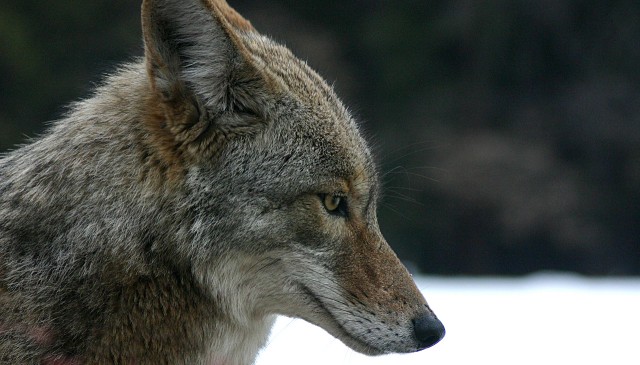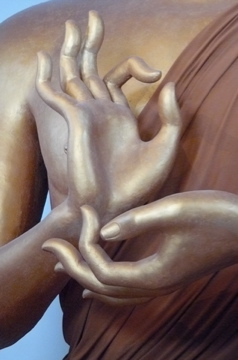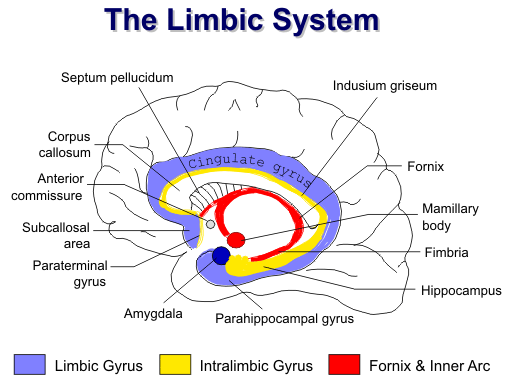Taking shots in the dark
Coyote populations continue to grow, despite being a popular hunting target
By Nick Stockton | Posted March 31, 2013
The best time to hunt coyotes is at between dusk and dawn. Once you scout a good spot you try to lure the beasts in, using hand held instruments to mimic the calls of different woodland animals. Maybe you choose to be a distressed rabbit, which sounds like a squealing baby. If that doesn’t work, you can yelp like a turkey or cackle like a Pileated woodpecker. On top of your head is a dim red light to help you spot movement. If you’re lucky, a pair of eyes shines back. After turning on the high powered beam attached to your rifle, you have a few seconds to determine what type of predator you’re looking at before you take your shot.
Tom Monko from Mechanicsburg, Pa., loves the sport’s technical challenges — hunting coyotes requires stealth, patience and a lot of scouting. In addition to being nocturnal, coyotes are also highly mobile and have superior senses of smell and hearing. Coyotes’ primary attribute, however, is their intelligence. From Native American folklore to modern research, nearly everyone who encounters coyotes comments on their cunning. Scientists have witnessed coyotes using sophisticated strategies to hunt — like teaming up with badgers to corner squirrels or using debris to set off traps and steal the bait.
This adaptive intelligence is what draws so many like Monko to the sport. “I enjoy it because it’s me against them.” He says successful coyote hunters are always scouting, always learning, always practicing their calls. Monko carries his hunting calls on a piece of braided leather he wears around his neck — his tools of the sport. One of the best calls, he says, is the field mouse. “They like the squeakiness.”
Where humans live, coyotes’ intelligence has made them a success and a nuisance. They’re often blamed for threatening livestock, many people have lost pets and there are even cases where humans have been attacked. Almost every state allows coyote hunting, and in the Northeast many have open seasons — there is no kill limit. In Pennsylvania, the season runs year-round.
In recent years, controversial hunting contests targeting coyotes have popped up all over the Northeast. Advocates say the contests are as valid as any other sport, that they contribute to the economy and help control coyote populations. Critics decry the hunts on moral grounds, and argue that these hunts might be doing the opposite of what they intend. “I’m not going to sit here and tell you [coyotes] never kill a sheep, they never kill a chicken, they never kill a cow, they never kill a deer,” says D.J. Schubert, a New Jersey biologist with the Animal Welfare Institute. “But,” he says, the hunts “aren’t solving the problems that the coyote hunt organizers think they’re solving.”
Hunting may actually contribute to coyotes’ reproductive success, according to conservationists like Schubert and Jon Way, an independent biologist who studies coyotes in Massachusetts. “One reason why coyotes are very successful is they are very social and ecologically variable. For a predator, they are extremely fertile,” Way says. Normally, female coyotes have litters of five to six pups. Large-scale hunting reduces competition for food, according to Way, which means more pups can survive until breeding season in the fall. “It doesn’t matter how many pups are born, it matters how many survive through their first fall,” Way says.
Way has published several studies that point to coyote density increasing in areas where they’ve been affected by humans. In one study, Way saw the population density in a single pack’s territory double after the breeding male was killed by a car. In coyote packs, typically only one pair bears litters. This disrupted the pack’s social structure, and gave way for multiple breeding pairs to occupy the same territory. Though the studies don’t directly measure the impact of coyote hunts, they suggest the same outcomes – that killing key members of a pack disrupts the social structure and leads to more breeding pairs sharing smaller areas. As with many things about coyotes, however, the question is far from settled.
Organized coyote hunts began in the Northeast in the mid-1980s. The Mosquito Creek Sportsman’s Association in Frenchville, Pa. was among the first, and is the largest hunt in the region. Its 22nd annual hunt, which was held in February, had nearly 4000 registered hunters. Dozens of other annual hunts have sprung up across the Northeast, and most emulate Mosquito Creek’s structure.
The rules are simple: Whoever kills the biggest coyote, judged by weight, wins the prize money — generally half of the registration revenue, which can be up upwards of $7,000. The coyotes must be killed between designated start and end times, and within certain geographic boundaries. At some hunts, Mosquito Creek included, judges give the winners polygraph tests to keep things honest. Though most hunts are smaller, Mosquito Creek allows its contestants to kill coyotes anywhere in Pennsylvania.
Sullivan County Sportsman’s Association in upstate New York also held its annual hunt in February. Jack Dancheck is the contest’s founder as well as his club’s current president. He says the coyote population has gotten out of hand, and contests like this barely help keep their numbers at bay. “We haven’t even put a dent in it. We had 715 hunters in the hunt and they only got 48 coyotes.” In addition to preying on pets and livestock, Dancheck complains that the coyotes are eating all his region’s small game, including turkeys, squirrel, grouse and rabbits.
Iconic out west, coyotes have only relatively recently expanded east of the Great Lakes. The first sighting in New York was in 1925. By 2010 coyotes were hunting ducks in Central Park. New York officials believe there may be up to 30,000 in the state, but because the predator is so elusive, there are no official counts. Pennsylvania probably has the most coyotes in the east, with some estimates as high as 50,000. But again, since the predator is so shifty, this number is tentative. “We have no population numbers on them, anytime, anywhere,” says Roland Kays, who studies coyotes at the North Carolina Museum of Natural Science. The only thing for certain, he says, is that their numbers in the east have increased: “They started at none, and now they’re at many.”
Coyotes are the most heavily hunted predator in North America, according to Pennsylvania State biologist Matthew Lovallo. “And in the face of that,” he adds, “they’ve increased their range tenfold.” Their expansion into the Northeast is most likely due to the decline of other top level predators. Wolves, bears and mountain lions have been decimated in the region because they need more territory, larger prey and can’t exist at the periphery of humans like coyotes can. “They’re such a generalist that they can occupy all kinds of vacant habitats,” Lovallo says.
Despite this, neither Kays nor Lovallo agree with the theory that hunting increases coyote populations. Not on an ecological level, Roland Kays says. Their numbers fluctuate with the amount of prey available, and hunting does little to control that number. He says there is little doubt that coyotes have been successful, but is skeptical that hunting has in any way contributed to this. As for Jon Way’s claims: “That’s just over-speculation,” Kays says. Hunting may free up more resources and cause females to breed at a younger age, but the studies don’t account for other factors, he says. For one, most of the research only looks at single territories — the population in one heavily culled area might swell because neighboring areas are emptying into it.
Also, as Lovallo points out, Ways studies were done in a suburban area, which generally has more resources available than somewhere in the wild. “I think what’s been lost is that the studies are being done in human-altered landscapes.” Lovallo thinks that the studies would need to be expanded to show a meaningful correlation between hunting and population growth. Lovallo thinks that the additional resources available in the suburbs contributed to the coyote density increases that Way observed. “I don’t think you’ll see that in wild systems.”
Even if hunting coyotes did control their population, hunter Jeff Millihard says that’s not the reason for the contests. “In the Mosquito Creek hunt this year, they had 4,000 people registered, and they only had 129 coyotes killed,” Millihard says, “that tells you something.” Though he doesn’t agree with Way’s hypothesis, he also says it isn’t hard to imagine that it could be true: Nature hates a vacuum. “The more food that coyotes, foxes, any animal have, the more young they’ll have,” Millihard says.
But long-term population control isn’t the only issue to consider. Millihard says hunting thins coyotes near farms and livestock, and helps control the spread of rabies and mange. Besides, for him hunting coyotes is more than a wildlife management effort. He explains that he and many others simply value the hunting experience. “With coyote hunting, you’re trying to outsmart that animal, and it’s enjoyable. It’s a challenge,” Millihard says. “People think hunters, all they want to do is kill something,” but it’s also a way to be alone in the woods and focused on something other than his job, his stress, or his problems, he says.
Millihard doesn’t compete in the hunting contests, but he believes the hunts are important, partly because a bunch of guys can get together on a weekend, kill some coyotes, win prizes and share a dinner — usually hamburgers, never coyote — on Sunday. “Every year they get together for the hunt and maybe that’s the only time all year they can get together.”
D.J. Schubert of the Animal Welfare Institute finds this type of bonding disgusting. Though he has never been to a coyote hunt, he has seen pictures, including of the kill pile — where coyote corpses are discarded after they are weighed. To him, this waste could be bad publicity for the sport. “I would encourage hunters to start advocating against these events, because they do detract from the image of hunters and hunting. It’s not rocket science that these [are the] types of hunts that the general public would find distasteful,” he says.
Tom Monko has been hunting coyotes with his brother Jim for the past 25 years. He is retired now and between hunts, he teaches youngsters about coyote hunting safety, tactics and law. “Have the proper license, look at the laws that pertain to predator hunting that apply to you.”
His success has been hard-earned: Monko confides that he didn’t harvest a single coyote for the first two years he hunted them. There are more prey options for Eastern coyotes, compared to their western cousins, so they are less desperate for a good meal. This means hunters have to work harder to lure them in. “Out here in the east have to use some extra strategy.”
Learning the calls, he says, is the most difficult skill to master, and takes hours of practice. Each call is like a different musical instrument, pitch tuned to a different animal. Each call’s authenticity relies on the hunter’s dedication — and his family’s tolerance. “Your wife usually makes you go outside or the dog starts howling.”
















